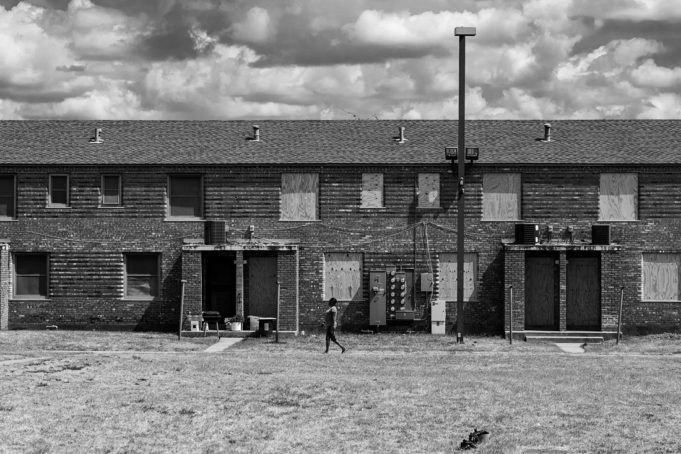Eva has lived at Butler Place for several years. Her extended family resided here for decades.
“I was just a kid when my Aunt Brenda lived here,” the 44-year-old Fort Worth native said. “It was nice back then, and I have fond childhood memories. It’s sad to lose some of my history, but I’m ready to move.”
Butler Place, Fort Worth’s oldest public housing apartments at 1201 Luella Street east of downtown, first opened in the 1940s as a works project under President Franklin D. Roosevelt’s New Deal. But it’s undergoing significant changes –– changes that are impacting both Butler Place inhabitants and the city. In a process that began in late 2017 and will continue through 2020, residents are relocating to better and more diverse neighborhoods across the city, and new opportunities are opening up for the use of the land.
During the late 1930s and early 1940s, many Fort Worth families, as well as others across the nation, were living in unsanitary conditions. The Butler complex was named after Henry H. Butler, a Civil War veteran and the first African-American teacher in Fort Worth. City leaders elected to build the 42-acre low-income apartment complex close to I.M. Terrell, the nearby school for black children. The red brick building once housed the original high school and later Carver-Hamilton Elementary. Since 1995, that building has been home to Fort Worth Housing Solutions (FWHS), an organization that reports directly to Housing and Urban Development (HUD) but works closely with the city.
Butler was a pleasant and safe place to live back in its day, but during the 1950s, with the construction of the north-south freeway, the residences became isolated. Units began to decline. Today, the complex is landlocked by Highways 30 and 35 and by Route 287.
“The property has concrete floors and an aging heating/air-conditioning system,” said Margaret Ritsch, director of public affairs for FWHS. “We’ve been receiving only about $1.2 million per year from HUD to maintain all our public housing units, and this includes the 300-unit Cavile Place also in Fort Worth.”
FWHS is participating in a new initiative called RAD, Rental Assistance Demonstration. RAD operates under HUD to address the nation’s deteriorating public housing inventory, converting public housing subsidies into rental assistance contracts. With these contracts, RAD seeks public and private funding for new construction as well as renovation where viable, keeping rentals affordable.
Currently, out of 412 original Butler Place units, 166 are still inhabited. By the end of the year, that number will decrease to 117, with total move-out planned by the end of 2020.
This phased approach began in December 2017 when the first 15 families moved to Stallion Pointe Apartments in Everman. The goal is to relocate all residents to new homes in better neighborhoods across the city. Rental payments are about the same as they were at Butler. RAD uses a lottery system that assigns a number to each household. When new apartments become available, residents are relocated as their numbers are drawn. Currently, the new units are located in more than a dozen apartment communities, including Alton Park Apartments, Campus Apartments, Palladium Fort Worth, and Standard at Boswell. A number of these properties have pools and other amenities. They are closer to job opportunities and – better – schools and grocery stores, conveniences that Butler Place lacked. The goal is to “de-concentrate” public housing into vibrant, mixed-income and mixed-use neighborhoods.
Although most residents are excited to move, Butler Place holds memories for many. Seventeen of the 42 acres are listed on the National Register of Historic Places. This designation was granted to mitigate the 2003 demolition of the Ripley Arnold Housing Projects on Weatherford Street downtown, land now occupied by Tarrant County College and, before TCC, RadioShack.
“Holding a national historic designation does not stop demolition,” according to John Roberts, Fort Worth architect and preservationist.
“There are no plans for demolition,” Ritsch said. “We want to honor Butler’s history. At the end of 2020, the Butler Place acreage will become available. Community input is extremely important as Fort Worth moves forward with making decisions on what to do with the property.”
Public workshops are being held by the city and will include representatives from the NAACP, Terrell High School Alumni Association, Metropolitan Black Chamber of Commerce, Tarrant County Black Historical and Genealogical Society, Historic Fort Worth, Downtown Fort Worth, Tarrant Transit Alliance, and the Fort Worth school district. The outcome of these meetings should be available in the upcoming weeks.
But for now, moving out is bittersweet. Angela, 58, moved to Butler from the West Side in 2012 when her husband died and his pension ceased. A community advocate, she works with Fort Worth’s housing representatives to ensure the relocations are fair and equitable.
“I will be moving to Keller in November, and I’m excited,” Angela said. “It’s not uncommon to wake up in the morning and see yellow tape across a door. The police have been good to work with us, but no one really understands what goes on here. Like everyone else, they just want to go home to their families at the end of the day. Some of the residents have said they are worried about not being accepted at their new homes. I tell the young people here they can’t move to one of these new places and continue their actions –– drinking and playing their boom boxes in the parking lot in the middle of the night. They have to change their behavior, or it won’t work.”
Another longtime Butler resident asked, “Will the problems residents face just follow them to their new place? Is Butler the failure of the residents or the city? Or maybe both?”













I remember being riding the bus from the west side to Carver Hamilton in Butler Housing at the end of the 1970’s. Bussing was a farce as there wasn’t much mixing between west side white kids and the Butler residents. I do remember that Butler seemed like a real community. However, I learned later in life from FWPD officers that Butler was basically a warzone in the early 1980’s. Unfortunately, it is isolated from the rest of the city by freeways so the residents are at a real disadvantage in getting to basic services. Two other contradictory footnotes, the Glass Key (FW people know what that happened there) was adjacent to Butler, and I.M. Terrell, home to the most loyal and proud alumni in the city is there too.
The ones that move out to the new home keep coming back and the ones that been trying to move out still in the butler’s and it’s sad because you got family that’s still in the butler’s trying to move out have a better life for their kids to a new area but the housing people Fort Worth Housing is making a hard and they do a lotto so if you pick the apartment if your lotto is not pick you don’t get that apartment. It’s sad because me and my children still live here still having problems with the mildew, alot of dirty in the wall and place is fall apart that been there getting worse and nobody in the housing to care since they dont live here i have small childrens and when you try to get a hold the head person mary some of fort worth housing employees try to make hard or give you the run around where you can get a hold of her about my concern as a resident
hi Shay. my name is Sean. i am a black photographer and documentarian. I would like to document the voices of this community so their voices get heard before the city fully removes all the tenants and knocks down the projects. would you be open to sharing your opinion?
if so please feel free to email me
seanlyles788@gmail.com
god bless